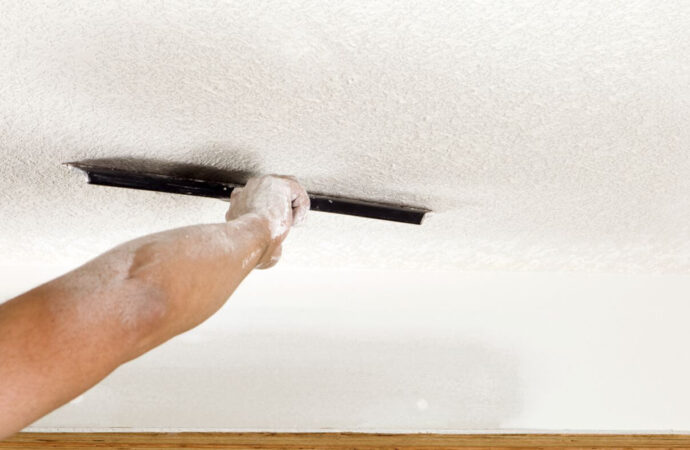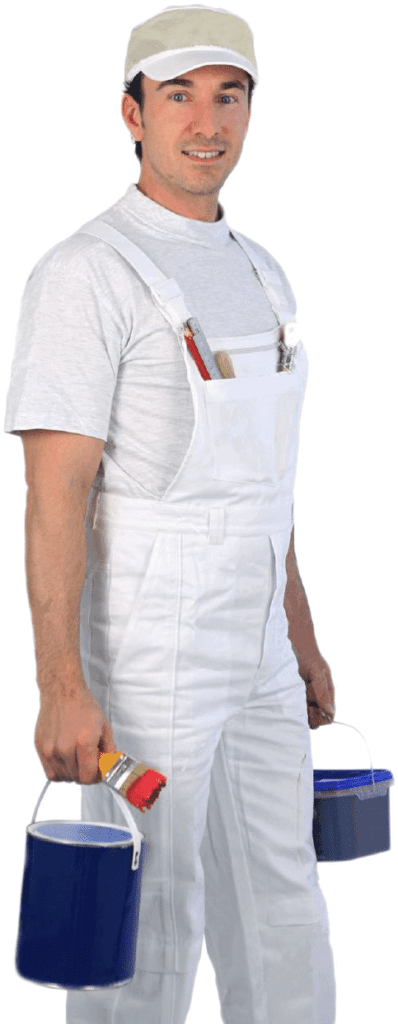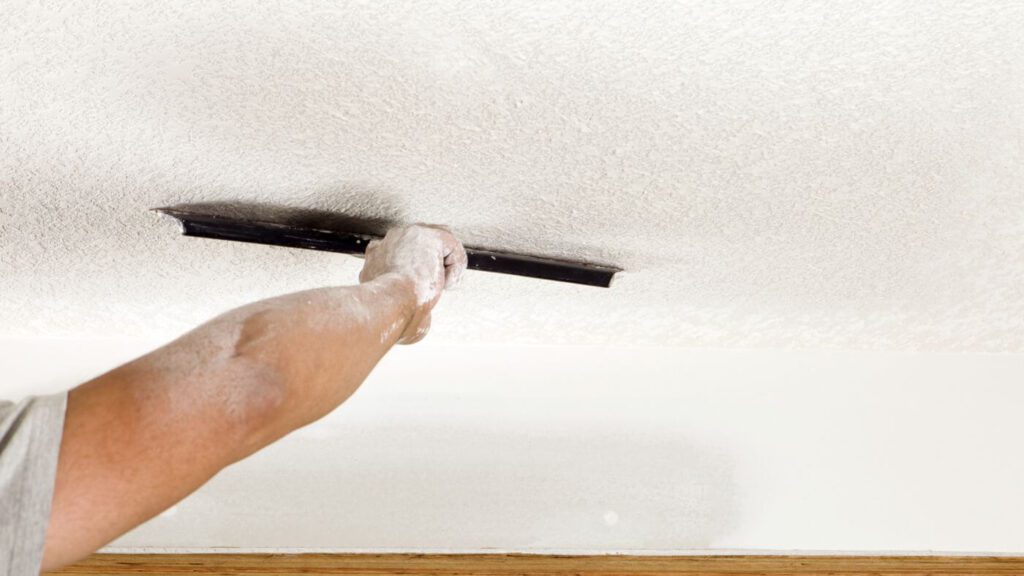Orange Peel Ceiling
Contact Us

Orange peel ceiling conceals imperfections like screw pops and bulging joints in drywall ceilings. The orange peel texture is applied using a ceiling texture hopper. The result is a ceiling that has slightly raised bumps, similar to an orange’s outer skin. The ceiling texture is often created using Gypsum plaster and a little water.
You can purchase plaster at hardware stores and paint shops. It is also known as joint compound or drywall mud. Before adding orange peel texture to ceilings, make sure you have primer on your drywall.
Remove all furniture and decor from the room. Tape the flooring with painter’s tape. Plastic should not have wrinkles.
The same plastic should be stretched over all walls and doors in the room. Use painter’s tape to attach it to the ceiling edge. Apply a coat of latex primer to the ceiling.
Use a flat roller with a low nap. Allow the primer to dry for 24 hours before applying a single layer. Primer ensures that the joint compound adheres evenly to the drywall surface.
Put joint compound in your drywall hopper. Add water to ensure plaster flows smoothly through the spray gun nozzle. Lightly spray the ceiling with the hopper’s gun, moving the gun in one direction. Allow the surface to dry for approximately two hours.
Spray another coat of orange peel texture on the ceiling. However, spray in the opposite direction. If the first layer of texture was applied horizontally, then the second coat should apply vertically. The second coat should dry for 24 hours. Use a rough nap roll to apply two or more coats.
Orange peel texture can be sprayed on walls and ceilings to create a similar texture to orange peel.
There are many reasons why an orange peel should be sprayed on walls and ceilings. Many people think that it is too complicated and won’t look nice.
Orange Peel Texture
Spraying orange peel texture is very easy. All you need are the right tools, some instruction, and a lot of practice.
Orange Peel Texture Walls: Benefits
Although textured walls are often considered outdated by many, there are a few reasons why you might want to spray orange peel texture on your ceilings or walls.
Orange peel walls last longer than flat walls. Orange peel walls stay longer than smooth walls because they can withstand minor dings, dents, and scratches. Orange peel is a popular choice for commercial and rental properties.
Orange peel can hide flaws in ceilings and walls very well. It can be challenging to get walls smoothened if you have a rental property or a home in poor condition. This can cost you a lot of money and new sheetrock. An orange peel texture can be applied quickly to make walls look great and inexpensive.

How to Spray an Orange Peel Perfectly
It is easy to spray a perfect orange peel texture. It would be best if you had a steady hand, the correct tools, and a suitable surface to achieve the ideal orange peel texture.
Bare drywall mud is used to create an orange peel texture. Once the water has been mixed in, it will resemble pancake batter. Fill a 5-gallon bucket with plus three drywall mud. Next, get your mixing tool and paddle. Mix the mud with water slowly while mixing it in. You don't want the mixture to become too wet. You're ready to go once the mixture reaches the consistency of pancake batter. After you have prepped your room and made the perfect batch of mud for spraying on your splatter texture - it's time to start spreading! You will need to fill your hopper with soil. Then, put on a dust mask. Mud can get in the air as you work. Spraying should be done approximately three feet from the surface. You won't stop spraying once you have pulled the trigger. Keep moving in an even space while overlapping roughly 50% each pass. Spraying orange peel texture requires practice and a rhythm. Spray a room until it is complete. Try spraying on a board or extra sheetrock before moving to your walls. When you are ready to spray, you don't want the first spray on your ceiling or walls. That's asking for trouble. This is the best time to get started with your Wagner Tex Spray. Grab your Wagner Tex spray, mixed texture, and an extension cord. You can also practice spraying on walls. However, if your wall texture isn't pleasing, you must remove it. Try spraying the orange peel texture thinly and thickly to see which texture you prefer. Some people like it thin enough to cover the walls. Others, including myself, like the orange peel thickened on walls with no visible drywall board. After you have set everything up and practiced, it is time to spray the splatter texture. It's a good idea not to spray your texture unless you have to. If the surface is uneven or too light, stop spreading and spray again. You can do this even after you've finished a room. You can add orange peel splatter to your texture even if it is dried. There are two options if you feel your texture is too thick or don't like the look. You can first scrape the texture off with a 9-inch mud knife if it is still damp. If you don't like the texture after it has dried, you can sand it off and start again. It should be easy to sand off, even though there is no paint on the texture. It's now time to clean up after you have completed spraying the orange peel texture. Wash your sprayer/hopper and any mud knives before it dries. This is the time to clean the floor. You may have covered the floor with drop cloths or concrete to make cleaning easier. Mix Your Mud to the Correct Consistency
Spray Your Texture
Cleanup
Tips for Painting Orange Peel Ceilings and Walls
It is easy to paint over orange peel texture. Cutting lines takes a bit more patience, but it is straightforward. This article will show you how to paint popcorn ceilings. It is the same process as orange peel ceilings. Be patient when cutting in the ceilings.
It is slower to cut in ceilings on textured walls with your paintbrush than to brush in lines on a flat wall. It would help if you slowed down when cutting into ceilings in textured walls. Please slow down and move the brush around to get it into the grooves. To help you choose the right paint brush for your job, check out our post, Everything About Paint Brushes.
Use a Thicker Roller Nap
For rolling textured walls, you will need a thicker nap roll. A nap roller 3/8″ – 1/2″ wide will work well for most flat walls. A 3/4″ nap roller is ideal for painting textured walls. The extra padding allows the roller to reach all textured areas and will keep you painting quickly without slowing down.
How to Remove Orange Peel Texture
Many people fear the task of removing splatter texture. However, with the right tools and instruction, it is not difficult. Orange peel can be removed by sanding drywall mud.
Tools Required to Remove Orange Peel Texture
Sanding splatter by hand is not something you want, but it would be a nightmare. I recommend that you get an electric drywall sander. Drywall sanders cost about one hundred dollars and are well worth the money. You can sell the project on Craigslist or rent it at Wellington Pro Painters & Popcorn Removal.
If you want to keep the area dust-free, I recommend connecting the drywall sander to a shop vacuum.
Sanding is the Best and Easiest Way to Remove Texture
Start the sander by selecting the lowest grit disc, 60 grit or80. A 60 grit disc can seriously damage the wall. Make sure you move the sander around. You should be able to remove the high points of the splatter texture quickly.
You’ll need to start sanding from the lowest to the highest number of your sanding disks, just like any other surface. You should only need to do one pass on each sanding disk. You can go up to 180 or even 240 grit if you want a smooth wall.
Check the Wall for Smoothness
After you have sanded all walls and worked through the various discs, it is time to inspect the wall for smoothness. This can be done in three ways: the basic eye test (hand test), the light test (light test), and the hand test. If the wall is still rough, you can look through it and see the details with your naked eyes.
If you cannot see the wall clearly, you can run your hands along. This will let you feel the roughness that the wall may have. You should not feel any cracks or blemishes. If you want to see all imperfections on the wall, shine a lamp or work light across it.
Additional Skim Coats to Make your Wall Smooth
You can skim coat walls if they aren’t yet smooth enough. Use Plus three drywall glue and a 9-inch mud knife to apply a thin layer of drywall paste to your walls. Allow it to dry for a few hours before giving the wall another sanding. A 180- or 240 grit disc is usually sufficient.
Locations We Serve
We offer the above services at the following locations within Wellington:
Additional HOAs We Service
If you are located in Palm Beach County and you don’t see your city/area listed above, don’t worry! We cover all of Palm Beach County. Fill out the contact form above or CLICK HERE and send us a message. We’ll get back to you asap!
Here is a list of our services you can get at Wellington Pro Painters & Popcorn Removal:
-
Commercial Painting Near Me
-
Commercial Popcorn Removal Near Me
-
Drywall Repair Near Me
-
Drywall Installation Near Me
-
Knockdown Texture Near Me
-
Orange Peel Ceilings Near Me
-
Residential Painting Near Me
-
Residential Popcorn Removal Near Me
-
Smooth Ceiling Finish Near Me
-
Commercial Painting Services
-
Commercial Popcorn Removal Services
-
Drywall Repair Services
-
Drywall Installation Services
-
Knockdown Texture Services
-
Orange Peel Ceilings Services
-
Residential Painting Services
-
Residential Popcorn Removal Services
-
Smooth Ceiling Finish Services
-
Commercial Stucco Installation Near Me
-
Complete EIFS Reinstallation Near Me
-
Custom Stucco and Texturing Near Me
-
Denglass Framing Near Me
-
EIFS Inspection Near Me
-
EIFS Installation Near Me
-
EIFS Wall Systems Near Me
-
Exterior Kitchen Stucco Near Me
-
New Construction Stucco Near Me
-
Stucco Application Near Me
-
Commercial Stucco Installation Services
-
Complete EIFS Reinstallation Services
-
Custom Stucco and Texturing Services
-
Denglass Framing Services
-
EIFS Inspection Services
-
EIFS Installation Services
-
EIFS Wall Systems Services
-
Exterior Kitchen Stucco Services
-
New Construction Stucco Services
-
Stucco Application Services

